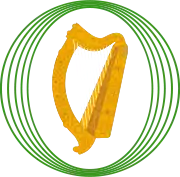Members of the 2nd Dáil
There were two elections in Ireland on 24 May 1921, as a result of the Government of Ireland Act 1920 to establish the House of Commons of Northern Ireland and the House of Commons of Southern Ireland. A resolution of Dáil Éireann on 10 May 1921 held that these elections were to be regarded as elections to Dáil Éireann and that all those returned at these elections be regarded as members of Dáil Éireann.[1] According to this theory of Irish republicanism, these elections provided the membership of the Second Dáil. The Second Dáil lasted 388 days.
| 2nd Dáil Éireann | |||||
|---|---|---|---|---|---|
| |||||
 | |||||
| Overview | |||||
| Legislative body | Dáil Éireann | ||||
| Jurisdiction | Irish Republic Southern Ireland | ||||
| Meeting place | Royal College of Surgeons Mansion House UCD (Earlsfort Terrace) | ||||
| Term | 16 August 1921 – 8 June 1922 | ||||
| Election | 1921 general election | ||||
| Government | Government of the 2nd Dáil | ||||
| Members | 128 | ||||
| Ceann Comhairle | Eoin MacNeill | ||||
| President of Dáil Éireann | Arthur Griffith from 10 January 1922 until 12 August 1922 — Éamon de Valera until 26 August 1921 | ||||
| President of the Irish Republic | Éamon de Valera from 26 August 1921 until 9 January 1922 | ||||
| Chairman of the Provisional Government | W. T. Cosgrave — Michael Collins from 16 January 1922 until 22 August 1922 | ||||
| Sessions | |||||
| |||||
In the election to the area designated as Northern Ireland, 52 members were elected from 9 geographic constituencies and Queen's University of Belfast. The Ulster Unionist Party won 40 seats, while Sinn Féin and the Nationalist Party (the successor to the Irish Parliamentary Party) won six seats each; 5 of those elected for Sinn Féin were also elected for constituencies in Southern Ireland, while Nationalist Party leader Joseph Devlin was elected to two seats in Northern Ireland. On 7 June Sir James Craig, leader of the UUP, became the first Prime Minister of Northern Ireland.
In the election to the area designated as Southern Ireland, 124 Sinn Féin candidates were returned unopposed from 26 geographic constituencies and the National University of Ireland constituency.[2] The University of Dublin constituency returned four Independent Unionist candidates, also unopposed. The four Independent Unionists met as the House of Commons of Southern Ireland on 28 June 1921, for one meeting only.
Those elected for Sinn Féin sat as the Second Dáil, calling themselves Teachtaí Dála (TDs). There were 125 TDs, taking into account that five represented two constituencies. The others elected did not respond to the invitation. Although the contemporaneous roll of Dáil membership included all those elected in both Northern Ireland and Southern Ireland, the database of Oireachtas members includes only those elected for Sinn Féin.[3] For clarity on the representation of constituencies, they are listed here in a single list.
It was during the 2nd Dáil that the Anglo-Irish Treaty was debated, and it was ratified on 7 January 1922.[4]
Election result
|
| |||||||||||||||||||||
Members by constituency
Only those elected for Sinn Féin chose to sit as TDs in the Second Dáil.
See also
References
- "PRESIDENT'S STATEMENT. - ELECTIONS". Houses of the Oireachtas. 10 May 1921. Retrieved 25 August 2018.
- "General Election of 24 May 1921". ElectionsIreland.org. Retrieved 4 September 2010.
- "TDs & Senators". Houses of the Oireachtas. Retrieved 25 August 2018.
- "Dáil Éireann debates". Houses of the Oireachtas. Retrieved 14 December 2019.
- "APPENDIX 19 DÁIL ÉIREANN". Houses of the Oireachtas. 16 August 1921. Retrieved 4 September 2010.
- Joseph Devlin was elected for two constituencies: Antrim and Belfast West.
- Michael Collins was elected for two constituencies: Armagh and Cork Mid, North, South, South East and West.
- Arthur Griffith was elected for two constituencies: Cavan and Fermanagh & Tyrone.
- Seán Milroy was elected for two constituencies: Cavan and Fermanagh & Tyrone.
- Éamon de Valera was elected for two constituencies: Clare and Down.
- Eoin MacNeill was elected for two constituencies: Londonderry and National University of Ireland.